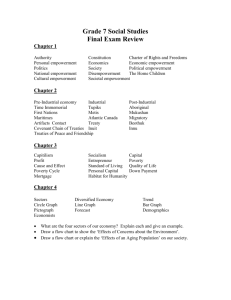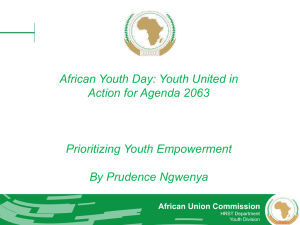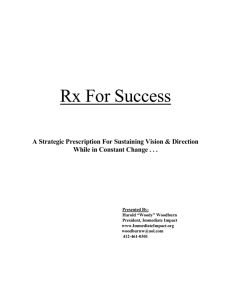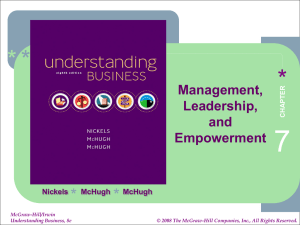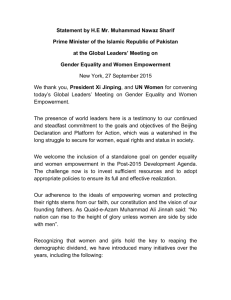IKEA SOCIAL INITIATIVE PROGRESS REPORT
advertisement
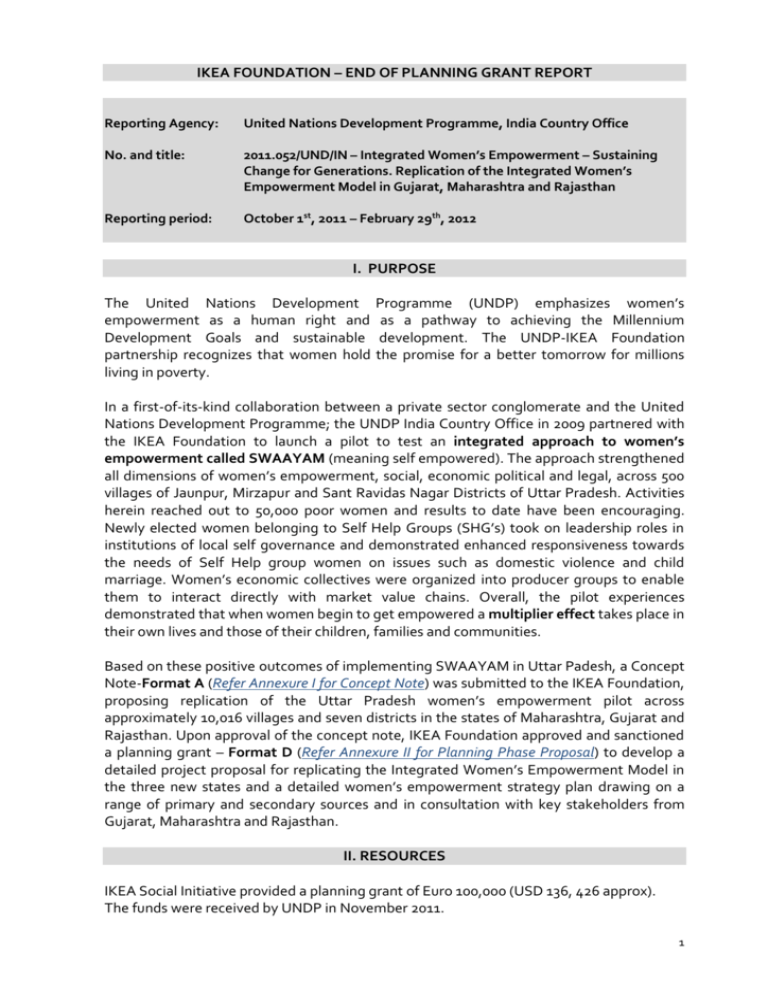
IKEA FOUNDATION – END OF PLANNING GRANT REPORT Reporting Agency: United Nations Development Programme, India Country Office No. and title: 2011.052/UND/IN – Integrated Women’s Empowerment – Sustaining Change for Generations. Replication of the Integrated Women’s Empowerment Model in Gujarat, Maharashtra and Rajasthan Reporting period: October 1st, 2011 – February 29th, 2012 I. PURPOSE The United Nations Development empowerment as a human right and Development Goals and sustainable partnership recognizes that women hold living in poverty. Programme (UNDP) emphasizes women’s as a pathway to achieving the Millennium development. The UNDP-IKEA Foundation the promise for a better tomorrow for millions In a first-of-its-kind collaboration between a private sector conglomerate and the United Nations Development Programme; the UNDP India Country Office in 2009 partnered with the IKEA Foundation to launch a pilot to test an integrated approach to women’s empowerment called SWAAYAM (meaning self empowered). The approach strengthened all dimensions of women’s empowerment, social, economic political and legal, across 500 villages of Jaunpur, Mirzapur and Sant Ravidas Nagar Districts of Uttar Pradesh. Activities herein reached out to 50,000 poor women and results to date have been encouraging. Newly elected women belonging to Self Help Groups (SHG’s) took on leadership roles in institutions of local self governance and demonstrated enhanced responsiveness towards the needs of Self Help group women on issues such as domestic violence and child marriage. Women’s economic collectives were organized into producer groups to enable them to interact directly with market value chains. Overall, the pilot experiences demonstrated that when women begin to get empowered a multiplier effect takes place in their own lives and those of their children, families and communities. Based on these positive outcomes of implementing SWAAYAM in Uttar Padesh, a Concept Note-Format A (Refer Annexure I for Concept Note) was submitted to the IKEA Foundation, proposing replication of the Uttar Pradesh women’s empowerment pilot across approximately 10,016 villages and seven districts in the states of Maharashtra, Gujarat and Rajasthan. Upon approval of the concept note, IKEA Foundation approved and sanctioned a planning grant – Format D (Refer Annexure II for Planning Phase Proposal) to develop a detailed project proposal for replicating the Integrated Women’s Empowerment Model in the three new states and a detailed women’s empowerment strategy plan drawing on a range of primary and secondary sources and in consultation with key stakeholders from Gujarat, Maharashtra and Rajasthan. II. RESOURCES IKEA Social Initiative provided a planning grant of Euro 100,000 (USD 136, 426 approx). The funds were received by UNDP in November 2011. 1 III. RESULTS Activities Supported under the Planning Grant: The Planning Grant was used for detailed project proposal development and this included three major steps as per the approved methodology proposed in the planning phase proposal to the IKEA Foundation (see Figure 1 below for a diagrammatic representation). Figure 1 (A) Situational Analysis & Interim Baselines Secondary Data Research & Primary Studies Stakeholder Interviews State-level Situational Analysis Reports (B) Stakeholder Consultations & Validation 2 State Consultations: Problem identification and prioritization; Root cause analysis; Identification of Interventions; Partnerships (C) Logical Framework Planning & Proposal Development Define the project goal, outcomes, activities, annual targets, outputs Proposal Writing Compiled Situational Analysis Timeline: 70 Days; Area Covered: 7 Districts, 14 Villages; Stakeholders Covered: Representatives from Government, Civil Society, Academic Institutions, UN Agencies, Private Sector, Banks, local leaders and 290 Women from project area The process of situational analysis and proposal development was initiated in October 2011 through an advertisement to identify and select an agency to lead the proposal development process. Natural Resource Management Consulting based in Delhi, Uttar Pradesh was selected through a rigorous selection process for the assignment. As part of Step (A) Situational Analysis and Interim Baseline Assessment, in-depth studies across social, economic, political and legal dimensions in the 7 identified project districts were conducted. Available secondary data on key development challenges across social, economic, political and legal dimensions faced by women were also researched. Extensive literature reviews were undertaken in all three states on issues pertaining to gender, women empowerment, women’s workforce in cotton cultivation, migration in agricultural sector, livelihoods, status and positioning of women in governance and legal awareness. This process helped refine the context, informed the problem analysis and highlighted the existing civil society initiatives already underway that support empowerment of poor women in the social, economic, political and legal domain in the seven districts. An interim baseline was conducted in 14 villages of the 7 project districts and involved 140 questionnaire-based interviews with women and migrant families. In addition, 14 interviews with Elected Women Representatives (EWRs) and Focus Group Discussions (FGDs) with 136 women from 14 Self Help Groups were conducted. FGDs were also conducted with secondary stakeholders, like small and medium cotton farmers (males), value chain actors in the agriculture and non-farm sectors and Elected Male 2 Representatives (EMRs) to harness their perceptions of the different dimensions of women empowerment and their expectations from women’s empowerment programs. Consultations were held with tertiary stakeholders comprising 32 local NGOs (working with cotton farmers, migrant labourers, and women’s SHGs), Government officials at the State, District, and Block levels (viz. Block Development Officers, National Bank for Agriculture and Rural Development representatives and Bankers, Nodal officers for SGSY1 and representatives from the State Departments of Women and Child Development, Rural Development, and Labour, Panchayati Raj and Justice). These activities together generated a comprehensive understanding of the social, economic, political and legal context in which the rural poor (especially families of cotton producers and labourers) operate and also helped to identify the key problems contributing to continued socioeconomic poverty and politico-legal disempowerment of women in the area. Under Step (B) Stakeholder Consultation and Validation, key findings of situational analysis studies were shared with various Government Organisations, NGOs, UN agencies and individual stakeholders through two Stakeholders’ Consultation Workshops organized in October 2011; one in Ahmadabad (on 10-11 October 2011, with stakeholders from Gujarat and Rajasthan), and the other in Pune (on 13 October 2011, with stakeholders from Maharashtra). Over 200 stakeholders participated in these workshops wherein participatory sessions enabled validation of findings of Situational Analysis studies, joint development of problem statements, problem prioritization, root cause analyses and generated a basket of interventions that can be taken up under the project. The workshops also served as a forum to identify potential partnerships that could be established to achieve the project objectives. These events also helped achieve necessary buy-in and provided a forum to share and assess the applicability of SWAAYAM in these new areas. Overall, stakeholders were very positive about the integrated women’s empowerment model and validated its applicability in the project districts. As part of Step (C) Logical Framework and Project Planning, the outputs of these workshops fed into the design of a detailed Logical Framework and Project Plan with project activities, output indicators, envisaged outputs and outcomes, and means of verification. This Logical Framework was shared with selected stakeholders and thematic experts during a Project Planning Workshop organized in Delhi on 10 January 2012, and subsequently finalized. An internal technical group (UNDP staff and officers from UN Solutions Exchange) comprised specialists in poverty reduction, financial literacy, livelihood development, gender, inclusion, governance, legal empowerment M&E and project management closely reviewed all components of the project framework, key performance indicators, strategy, activities and budgets and provided detailed strategy feedback, identified key areas of interventions and suggested strategic collaborative partnerships, all of which fed into proposal finalization (Refer Annexure III and IV for Proposal (Format B) and Budget (Format C). The proposal is now final and is under review by the IKEA Foundation for comments. Upon due approval, UNDP through the Replication of the Integrated Women’s Empowerment Approach will reach out to over 1 million women and their families in the three new states. SWAAYAM implemented here will aim to bring transformational change 1 Swaranajayanti Gram Swarozgar Yojana i.e the National Rural Livelihood Mission aims to reduce poverty among rural BPL households by promoting diversified and gainful self-employment and wage employment opportunities which lead to an appreciable increase in income on a sustainable basis. 3 addressing both women’s condition– and bring improvements in their income, health, nutrition and education levels as also women’s position – bringing favorable transformation in external power structures and decision making systems. IV. FUTURE WORK PLAN The project proposal and budget (Format B and C) have been developed and submitted to the IKEA Foundation for review. V. INTERIM FINANCIAL STATEMENT Planning Grant: Euro 100,000 Start Date: 01 October, 2011 End Date: 29 February, 2012 Figures in USD Activities Situational Analysis and Interim Baseline prepared. Project Design / Strategy Formulated. LFA Planning Workshop and detailing of implementation. Project Management & Monitoring Total *equivalent to Euro 100,000 Budget 81,036 Expenditure 23,572 Balance 57,464 33,752 22,891 10,861 12,715 3,482 9,233 8,923 136,426* 3,496 53,441 5,427 82,985 VI. ANNEXURES Annexure I: Annexure II: Annexure III: Annexure IV: Format A - Concept Note Format D - Planning Phase Proposal Format B – Final Project Proposal Format C – Final Budget 4



